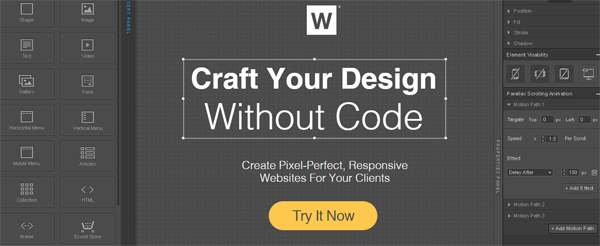Web design is an always changing industry. Best practices evolve over time and new approaches routinely spring up, giving web designers new techniques with which to create powerful online experiences. Inevitably, as the industry changes and evolves, “truths” that were once seemingly indisputable start to become outdated and irrelevant. In this article, we will take a look at 5 website truths that are actually no longer true and what new reality has replaced them.
You Need To Know How To Code To Build a Professional Website
For many years, the visual look of a website was created by a designer and then turned over to a developer to be hand coded into working web pages. This scenario, while common, includes a number of potential breakpoints and problems. Hand coding a website can be an expensive and time consuming process, and it requires a designer to hand over their work and hope that the developer will accurately recreate that work in the pages they build. Thankfully, there is now another way to build websites.
Designers who want more control over the web design process can now turn to a solution like Weybdo. A cloud-based web design platform, Webydo “enables graphic designers to create and manage exceptional HTML websites, without writing code.” Powerful features like responsive multi-device support, parallax scrolling, Ecommerce, and even CMS editing capabilities can easily be added to a website – all without needing to write any code by hand. The designer focuses on design and the software creates the code necessary to bring that page to life, effective eliminating the “truth” that you need to know how to code to build a professional website!
People Need Instructions On How To Use A Website
A successful website design is one that is easy to use and intuitive. If you need to add detailed instructions to a site, then that is often a failure in the design. Unwieldy blocks of instructions are not only unlikely to solve problems, but people do not want to read those instructions. They just want to use the website.
Of course, there are instances where some level of user guidance is needed. Interactions or applications that are truly unique will require some kind of training, but the vast majority of websites are actually very similar to other sites, whether they are Ecommerce, news-focused, etc., and therefore should not require instructions.
No One Would Use a Mobile Device To Access Your Site
Today, people are visiting websites on a wide variety of devices with a range of different screen sizes. In fact, industry analysts predict that website traffic patterns will continue a move towards mobile devices, with more than 50% of worldwide web traffic coming from those devices in the coming years. Not only are people coming to websites on mobile devices, but they are increasingly expecting more out of their mobile website experience!
Gone are the days of “mobile users” only looking for directions or a company’s phone number. Customers want access to the same content that they can find on the desktop version of a website, but they want a layout and experience suited to the mobile device and whatever screen they are using. This is where responsive web design comes into play.
A “responsive website” is one whose layout can respond to different screen sizes, presenting an experience suitable to a variety of different devices or screens. These sites can be developed from scratch or built using an existing framework. The aforementioned Webydo platform also includes a pixel perfect responsive editor that can be easily add responsive support to a website built on that software.
However a site is built, the reality is that users are coming to that site on mobile devices, so that site must now serve an increasingly mobile-centric audience.
Everyone Has High Bandwidth Connections These Days
As of last year, the average size of a webpage was a whopping 2MB. The bulk of this size is from the images that we add to our websites. Many people argue that this is acceptable because, as our webpage sizes increase, so does the bandwidth speed of Internet connections. This is unfortunately not the case for all people, however.
Believing that all of a site’s visitors will have fast connections is dangerous thinking. There are still many areas of the world that struggle to use the Internet at painfully speeds. Even in areas where connection speeds are generally fast, a site’s visitors may be accessing those pages from a mobile device on a network that is unreliable or which has download limitations. If a website is bloated with unoptimized images, unnecessary videos, or other unwieldy content, it will pose problems for that site’s visitors.
By ensuring that websites are cognizant of performance and download quickly, you give users a better experience – which is good, because the reality is that not everyone has a high bandwidth connection these days.
People Will Fill In a Website Form
The final “truth” we will debunk is about website forms and whether or not visitors will use those forms.
Requesting information from a website’s visitors is valuable and sometimes necessary, but simply asking for someone’s information is not enough. Very few people will be willing to complete a form unless they see some value in doing so. A few examples of valuable reasons to complete a form would be for a download of some kind, registering for an event, or to create an account to make a purchase. In each of these cases, there is a legitimate reason for that site’s visitors to complete the form. If, however, you simply add a form without also adding any information on why people should give you that information or what they can expect in return, then there is a small chance anyone will be inclined to complete that form.
Asking for too much information can also be a turn-off for many visitors. If you do need to add a form to a website, be sure to ask for only the information that is needed.
Website visitors will fill in forms, as long as you make those forms easy to complete and provide a compelling reason for them to do so.
In Summary
The web design industry is always evolving. As such, the “truths” that we often cling to are subject to change as well. An important part of a web designer’s job is to constantly question these truths and be ready to adjust our thinking as the industry changes around us.
















